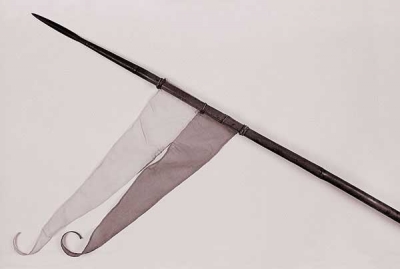Ceremonial lance (1955.1.1)
 EnglandCeremonial lance from England, Europe. Thought to have been collected by Henry Balfour by 1939. Found unentered and added to the Museum's colections in 1955.
EnglandCeremonial lance from England, Europe. Thought to have been collected by Henry Balfour by 1939. Found unentered and added to the Museum's colections in 1955.
Although it is not apparent in this tinted black and white photograph, the pennant on this English Royal lance is bright red and white. The 2.7 metre ash shaft is part-bound in leather and it has a steel tip and pip-clayed shoulder strap (not shown).
The name derives from lancea, the Roman throwing javelin. However, from the medieval period, the term 'lance' came to refer specifically to a type of staff weapon used by cavalry. For over 300 years it was an effective battlefield weapon and many European armies did not finally abandon it until after the First World War. It is still used in parades or processions where it is held vertically, the butt lodged in a special socket attached to the saddle or stirrup known as a 'lance bucket'.
The shaft is inscribed '12 R.L. 361 Enfield 3168' (the name refers to the name of the owner, not the place of manufacture). The 12th Royal Lancers ('12 RL') were also known as the Prince of Wales's who began life in 1715 as Light Dragoons (mounted swordsmen) raised in Berkshire to combat the Jacobite rebellion in Scotland. They gained a very high reputation for steadiness, dashing and gallantry throughout the Napoleonic wars, and played an integral part in many of its most significant battles - notably the siege of Toulon, at Alexandria, throughout the Spanish Peninsula, and at Waterloo. However, it was only at the latter engagement that they began to use lances and after victory they changed their status and name to the '12th, Prince of Wales, Royal Lancers'.
The red of the pennant was intended to match the scarlet plume and tunic facings of the 12th's uniforms. The pennant was worn purely for ceremonial occasions and would have been removed once battle was joined.





